Tropicália, also known as tropicalismo, was a Brazilian artistic movement that arose in the late 1960s. It was characterized by the amalgamation of Brazilian genres—notably the union of the popular and the avant-garde, as well as the melding of Brazilian tradition and foreign traditions and styles. Today, tropicália is chiefly associated with the musical faction of the movement, which merged Brazilian and African rhythms with British and American psychedelia and pop rock. The movement also included works of film, theatre, and poetry.

Hylidae is a wide-ranging family of frogs commonly referred to as "tree frogs and their allies". However, the hylids include a diversity of frog species, many of which do not live in trees, but are terrestrial or semiaquatic.
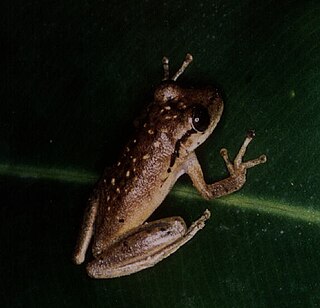
Scinax is a genus of frogs in the family Hylidae found in eastern and southern Mexico to Argentina and Uruguay, Trinidad and Tobago, and Saint Lucia. These are small to moderate-sized tree frogs, drably colored. Duellman and Wiens resurrected this genus in 1992. The name originates from the Greek word skinos, meaning quick or nimble.
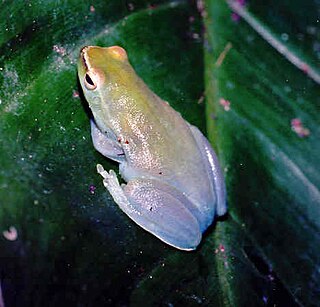
Sphaenorhynchus is a genus of frogs in the family Hylidae. They are also known as lime treefrogs or hatchet-faced treefrogs. They are found in the Amazon and Orinoco River basins of South America, the Guianas, Trinidad, and southern and eastern Brazil. The majority of the species are associated with the Atlantic Forest domain in Brazil.

Dendropsophus marmoratus is a species of frog in the family Hylidae. It is found in the Amazon rainforest and montane forests in the eastern piedmont, in Bolivia, Brazil, Colombia, Ecuador, French Guiana, Guyana, Peru, Suriname, and Venezuela. Its natural habitats are subtropical or tropical moist lowland forests, intermittent freshwater marshes, and heavily degraded former forest. "Marmoratus" in Latin means "marble," perhaps referring to the dorsal coloring pattern. It is threatened by habitat loss.
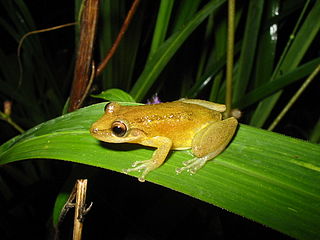
Scinax fuscomarginatus is a species of frog in the family Hylidae. It is found in northwestern Argentina, Paraguay, eastern Bolivia, southern, central, and eastern Brazil, and in scattered localities in the lowlands of eastern Venezuela and savannas of Guyana and southern Suriname as well as adjacent Brazil. As currently defined, it is one of most widespread Neotropical frogs; the northernmost records refer to what was formerly recognized as Scinax trilineatus. Common name brown-bordered snouted treefrog has been coined for this species.
Sphaenorhynchus platycephalus, commonly known as the South American lime treefrog or Lutz's lime treefrog, is a species of frog in the family Hylidae. It is endemic to south-eastern Brazil where it occurs in the Serra do Mar and Serra da Mantiqueira ranges in the states of Rio de Janeiro, São Paulo, and Minas Gerais. However, Araujo-Vieira and colleagues suggests that the Serra da Mantiqueira population could represent Sphaenorhynchus canga; the two species are similar.
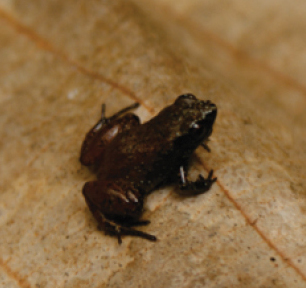
Adelophryne gutturosa is a species of frogs in the family Eleutherodactylidae. It is found on the Guiana Shield from eastern Venezuela through Guyana to French Guiana and adjacent Brazil (Amapá), possibly extending to Suriname. Its type locality is Mount Roraima. Its local Spanish name is ranita guturosa.
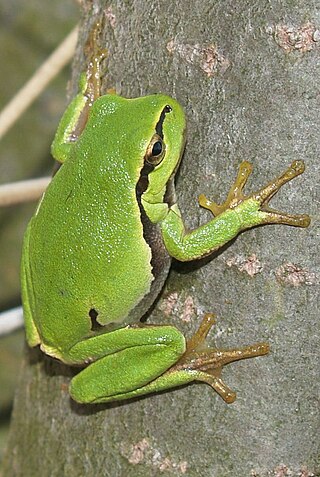
Hylinae is a large subfamily of "tree frogs", family Hylidae.

Dendropsophini is a tribe of small neotropical tree frogs in the subfamily Hylinae. They are distributed from southern Mexico, throughout Central America, and down South America to northern Argentina and Uruguay. Removed from the synonymy of Hylinae in 2016, this taxon was formerly considered its own subfamily before being reclassified as a tribe. As defined by Favovich et al. in 2005, the tribe Dendrosophini contains the members of three former subfamilies within the Hylidae prior to taxonomic rearrangement: Dendropsophinae, Pseudinae, and Scinaxinae.

Scinax tymbamirim is a frog in the family Hylidae. It is endemic to Brazil.
Scinax tigrinus is a frog in the family Hylidae. It is endemic to Brazil.
Scinax rupestris, the Veadeiros snouted tree frog, is a species of frog in the family Hylidae. It is endemic to Brazil and has been found in the state of Goiás.
Scinax cabralensis is a frog in the family Hylidae. It is endemic to Brazil. Scientists observed some of these frogs 1070 meters above sea level.
Scinax rossaferesae is a frog in the family Hylidae. It is endemic to Brazil and has been observed in the Guartelá Canyon area.
Dendropsophus counani is a frog in the family Hylidae. It is endemic to Brazil, French Guiana, Suriname, and Guyana.
Dendropsophus ozzyi is a frog in the family Hylidae. It is endemic to in Brazil.
Sphaenorhynchus canga is a frog in the family Hylidae. It is endemic to Minas Gerais, Brazil.
Scinax cosenzai is a species of frog in the family Hylidae. It is endemic to Brazil. People have seen it in the Parque Estadual da Serra do Brigadero in Minas Gerais.

Phyllodytes praeceptor is a species of frog in the family Hylidae endemic to coastal areas in the state of Bahia in Brazil. It has also been seen in Serra da Jiboia, 694 m above sea level.










